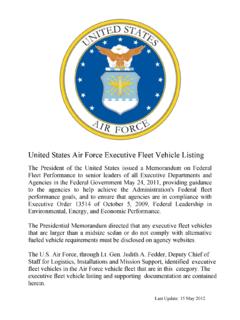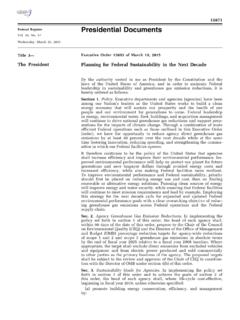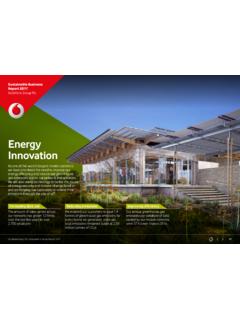Transcription of NYC Clean Fleet
1 December 2015 NYC Clean Fleet New york city will lead by example in pursuing 80 50 transportation emissions reductions by improving the sustainability of its municipal vehicle Fleet 1 NYC Clean Fleet Overview Climate change is an existential threat to New Yorkers and the world, and New york city is leading the way in both reducing our contributions to climate change and addressing its impacts. In One New york : The Plan for a Strong and Just city (OneNYC), the city of New york affirmed its commitment to reduce its overall greenhouse gas (GHG) emissions 80 percent below a 2005 baseline by 2050 (80 50).
2 1 To advance this goal, OneNYC implementation efforts are pursuing GHG emissions reductions opportunities in four major sectors: buildings, energy supply, transportation, and solid waste. To meet New york city s 80 50 goal, annual transportation sector GHG emissions will likely need to drop by 7 million metric tons (12 percent of the city s total 2005 emissions) in the coming decades. For context, in 2013 the transportation sector which includes private vehicles, freight, and mass transit (subway, commuter rail, and bus) was responsible for million metric tons of GHG emissions, or 24 percent of the city s total In addition to GHGs, on-road vehicles emit particulates and other air pollutants such as nitrogen and sulfur oxides (NOx and SOx).
3 These air pollutants are detrimental to public health (increasing premature mortality and the number and severity of asthma and cardiovascular disease), as well as the economy (as poor health causes New Yorkers to miss work and school). To meet its ambitious GHG emissions reduction goals for the transportation sector, New york city will need to ease reliance on fossil-fueled vehicles. This can be achieved by adopting a portfolio of strategies, including expanded access to transportation alternatives mass transit, biking, and walking as well as cleaner fueling technologies ( , biofuels, hydrogen, natural gas and electricity) to power remaining vehicle travel.
4 The city of New york seeks to lead by example in the transition to a less carbon-intensive transportation sector. As the Mayor s Office works to advance the policy and technology innovations outlined in OneNYC, the city government is launching a multi-agency Fleet sustainability plan to aggressively cut emissions from its own vehicles while ensuring agencies can meet their vital operational needs. With more than 29,000 Fleet units, decisions regarding investment and procurement for the New york city government Fleet can catalyze the uptake of zero-emissions, Clean , and renewable solutions for vehicles and fuels of privately owned fleets and those of other municipalities.
5 As a result of NYC Clean Fleet , New york city will: Add 2,000 electric vehicles (EVs) to its municipal vehicle Fleet by 2025, which would give New york city the largest EV Fleet of any city Achieve a 50 percent reduction in greenhouse gas emissions from Fleet operations below 2005 levels by 2025 and an 80 percent reduction by 20353 equivalent to decommissioning a 65 MW coal power plant in NYC or planting 6,000 2 LARGEST CATEGORIES IN NEW york city Fleet (SOURCE: DCAS) 025005000750010000 SnowmobileOtherBusGolf CartAmbulanceSweeperFire TruckLight TowerMaterial HandlingDump TruckConstruction VehicleATV/Scooter/MotorcyclePickupSUVVa nMedium/Heavy-Duty TruckSedanNonemergencyEmergencyNew york city s Vehicle Fleet New york city government operates a Fleet consisting of 27,152 fuel-burning vehicles.
6 These assets span more than 100 Fleet categories and serve a variety of agency operational needs. Although most Fleet vehicles run primarily on traditional internal combustion engines (ICEs), more than 60 percent of Fleet assets run at least partially on alternative fuels; nearly 10,000 Fleet vehicles run on biodiesel blends (B5 or B20), more than 5,000 vehicles are hybrids fueled by gasoline, diesel, or solar power, over 800 run on electric (including 323 on-road EVs), and another 250 run on either compressed natural gas (CNG) or propane.
7 In fiscal year 2015, city vehicles burned million gallons of carbon-based fuel, of which 60 percent was diesel (93 percent of which was blended with biodiesel) and 40 percent was gasoline. The emissions from this magnitude of combustion are significant in 2013, GHG emissions from the city government vehicle Fleet accounted for almost 4 percent of New york city s total on-road transportation-related GHG In 2015, the city on-road Fleet generated more than 255,000 metric tons of GHGs (CO2e), nearly 500 metric tons of nitrogen oxides, and around 6 metric tons of fine ,7 These emissions are comparable to those of an 80 MW coal plant located right in the heart of New york city .
8 city agencies are already making strides, as Fleet emissions in 2015 were 11 percent below 2005 levels. A portion of this progress has come from streamlining the size and utilization of the city Fleet ; the city recently downsized its Fleet by 500 vehicles, and has enrolled 600 agency vehicles in Zipcar s FastFleet car-sharing network to reduce underutilized agency Fleet capacity. On a Fleet -wide level, the Department of Citywide Administrative Services (DCAS) is on track to install fuel management equipment in all Fleet units by the middle of 2016, which will allow Fleet managers to monitor fuel consumption, fuel economy, and driving patterns ( , idling).
9 city agencies are also poised to replace or retrofit 90 percent of diesel on-road vehicles by 2017 to meet or exceed the Environmental Protection Agency s 2007 heavy-duty engine and vehicle emissions standards. BREAKDOWN OF city AGENCY FLEETS BY WEIGHT CLASSIFICATION (SOURCE: DCAS) 0200040006000800010000 DOHDOCDEPFDNYDCASDOTDPRDSNYNYPDL ight-DutyMedium-DutyHeavy-DutyOther 3 VEHICLE AIR EMISSIONS BY city AGENCY IN FISCAL YEAR 2015a a Fuel consumption data (gasoline and diesel by agency) from DCAS b Global warming potential from Appendix J of 2013 New york city GHG Inventory ( city of New york , 2014)
10 C DOE figures do not include school buses operated under contract d Uses average fuel economy ( mpg gasoline, mpg diesel) from FHWA s 2011 Highway Statistics, Table VM-1 (2013) e Uses average in-use emission rates of NOx and for gasoline from EPA (2008a) and for diesel from EPA (2008b) 020,00040,00060,00080,000100,000 DOHDOEDOCDCASDEPDPRDOTFDNYNYPDDSNYCO2e (t)a,b,c 050100150200 DOHDOEDOCDCASDEPDPRDOTFDNYNYPDDSNYNOx (t)a,c,d,e 05001,0001,5002,0002,5003, (kg)a,c,d,e 4 city agencies are also testing technologies to reduce emissions from specialized vehicles without compromising performance.
















